Introduction
- Hospital-acquired infections (HAIs) are contracted in clinical settings.
- Associated with significant morbidity and mortality.
- Hand washing (HW) – precautionary practice for HAI prevention.
- HW may involve soap & water or alcohol-based hand-rubs.
- Thesis: HW knowledge & compliance is critical for improved outcomes.
Hospital-acquired infections (HAIs) are illness contracted in the hospital environment. They are associated with significant morbidity and mortality. One precautionary measure that can prevent HAIs is hand washing (HW) before and after each patient contact. Adherence to HW guidelines is required to reduce HAI rates.
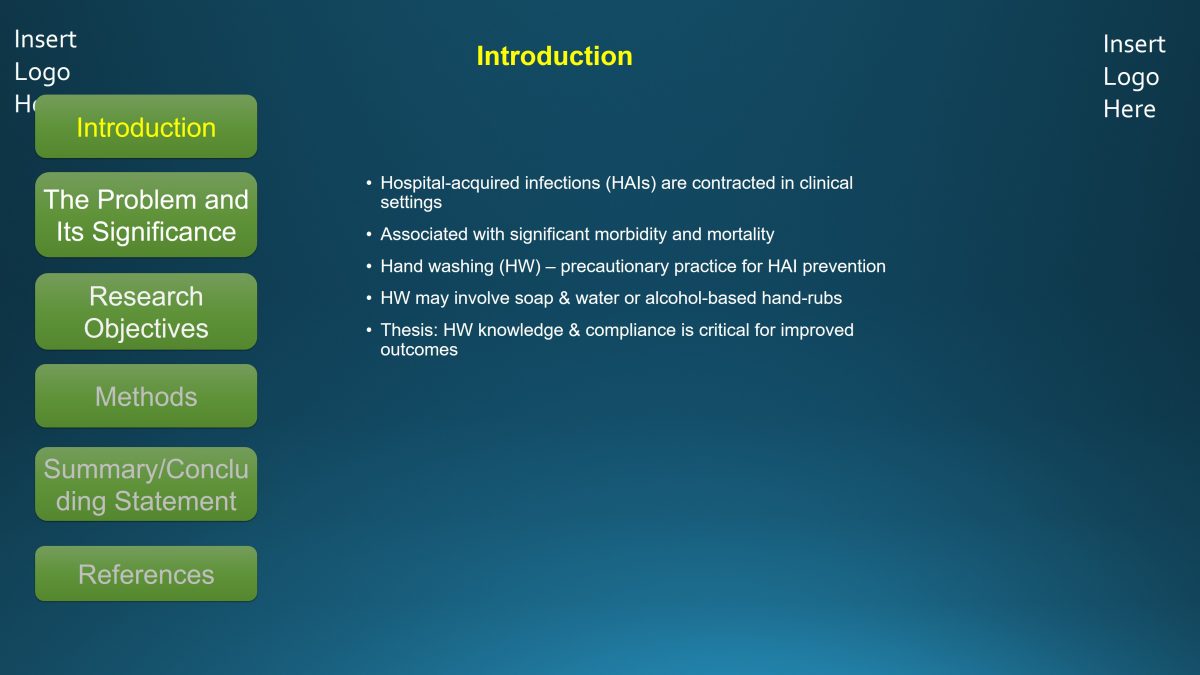
The Problem and Its Significance
- Scope & Importance:
- HAIs are infections acquired in clinical settings.
- Leading cause: pathogen transmission during contact/care (Magill et al., 2014).
- Procedure-related or device-related.
- HAIs account for high morbidity, mortality, & costs.
- UTIs, surgical-site infections, pneumonia, etc.
- In 2011, 722,000 HAIs reported & 75,000 fatalities (Magill et al., 2014).
- US HAI prevalence is 3.5-9.9% (Park et al., 2014).
- Costs arise from extended LOS & readmission rates.
- HAI rate reduction – an important quality indicator.
- Potential Application to Clinical/Educational Practice:
- HAI prevention requires transmission-based precautions.
- Hand washing (HW): Simple precautionary measure for preventing HAIs.
- Adherence to recommended HW practices – lower HAIs (Ellingson et al., 2014).
- Soap and water.
- Alcohol-based hand-rubs.
- Noncompliance high among clinicians (>50%) (Ellingston et al., 2014).
- HAIs in surgical wards: wound infections.
- Increase LOS & healthcare costs; cause discomfort.
- Surgical-wound infections are ~1/4 of all HAIs (Magill et al., 2014).
- HW compliance could potentially reduce hospital HAI rates.
- Conceptual Definitions of Key Variables:
- Hand washing: a disinfection practice to reduce HAI risk.
- Hospital-acquired infections: inpatient pathological states acquired in hospitals.
- Inpatient: an ill person receiving institutional care.
- Surgical-site infections: sepsis in post-operative wounds.
- Pathogen: An infectious agent, e.g., bacteria.
- Theoretical Rationale:
- Theoretical framework utilized: planned behavior theory (PBT).
- PBT: a decision-making framework
- Social behavior depends on perceptions.
- Perceptions modulated by “attitudes & beliefs about control” (Javadi, Kadkhodaee, Yaghoubi, Maroufi, & Shams, 2013, p. 53).
- Subjective attitudes or norms drive behavior.
- Normative beliefs are expected group/individual goals.
- Perceived control depends on norms & beliefs.
- Nurses’ control & beliefs influence HW practice intentions.
- Goal: improve post-surgical HAI outcomes.
Hospital-acquired infections (HAIs) are patient pathological states, e.g., urinary tract infections (UTIs) and pneumonia, which originate from within hospital settings. According to Al-Tawfiq, Abed, Al-Yami, and Birrer (2013), pathogen transmission during nurse-patient contact – procedure or device insertion or removal – is implicated in HAIs that are associated with high morbidity, mortality, and healthcare costs due to an extended length of stay (LOS) and high readmissions. In 2011, 722,000 HAIs were reported with 75,000 of them resulting in deaths (Magill et al., 2014). Currently, HAI prevalence in the US is estimated to be 3.5-9.9% (Park et al., 2014). Therefore, HAI rate reduction is an important quality indicator for hospitals.
HAIs can be prevented through transmission-based precautions. One such safety measure is hand washing (HW). Adherence to HW practices – soap and water or alcohol-based hand-rubs – is associated with lower HAI rates. Noncompliance by clinicians, which is as high as 50%, increases the HAI risk (Ellingston et al., 2014). Common HAIs in surgical wards are wound infections that account for one-quarter of all HAIs.
Hand washing is antiseptic practice meant to lower the risk of HAI. Hospital-acquired infections are pathological states absent in the patient at the time of admission, which implies that they were acquired within the hospital environment. An inpatient is an ill person admitted for a particular condition. Surgical-site infection refers to sepsis in post-operative wounds. A pathogen is an infectious agent, such as a bacterium or fungi.
The theoretical model utilized in this study is the planned behavior theory (PBT), a decision-making framework. PBT holds that social behavior depends on perceptions modulated by “attitudes and beliefs about behavioral control” (Javadi et al., 2013, p. 53). The subjective norms drive behavior, while normative beliefs shape group or individual goals. Perceived control influences the intention to display a particular behavior, e.g., hand hygiene.
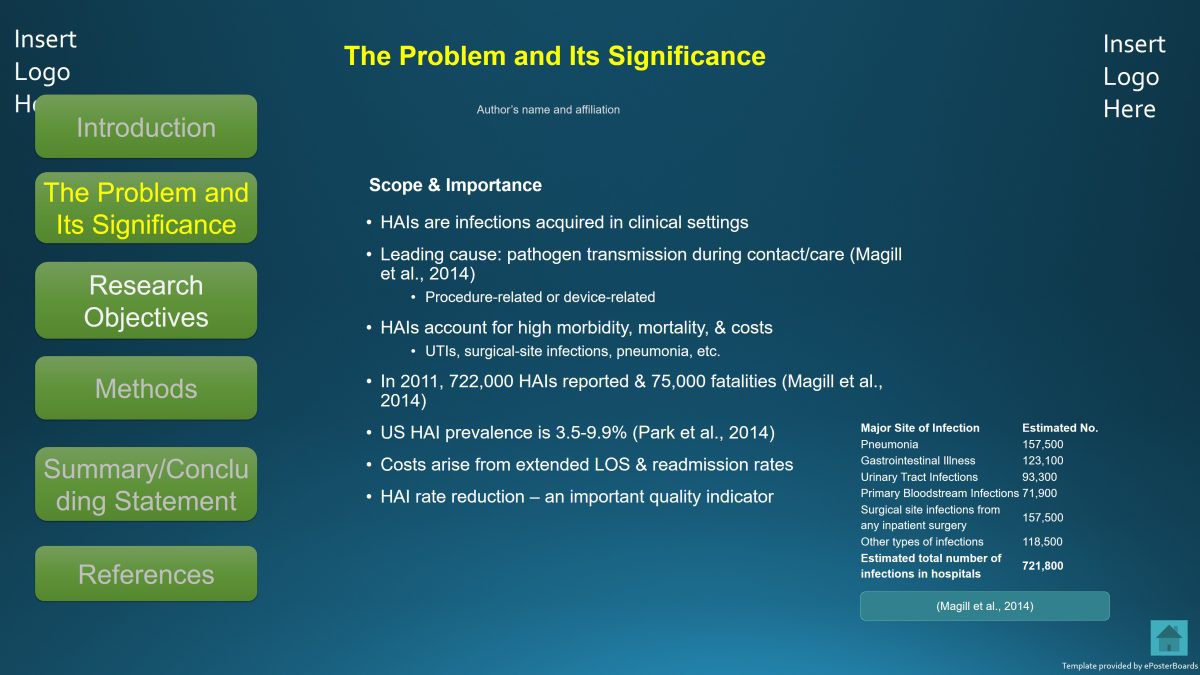
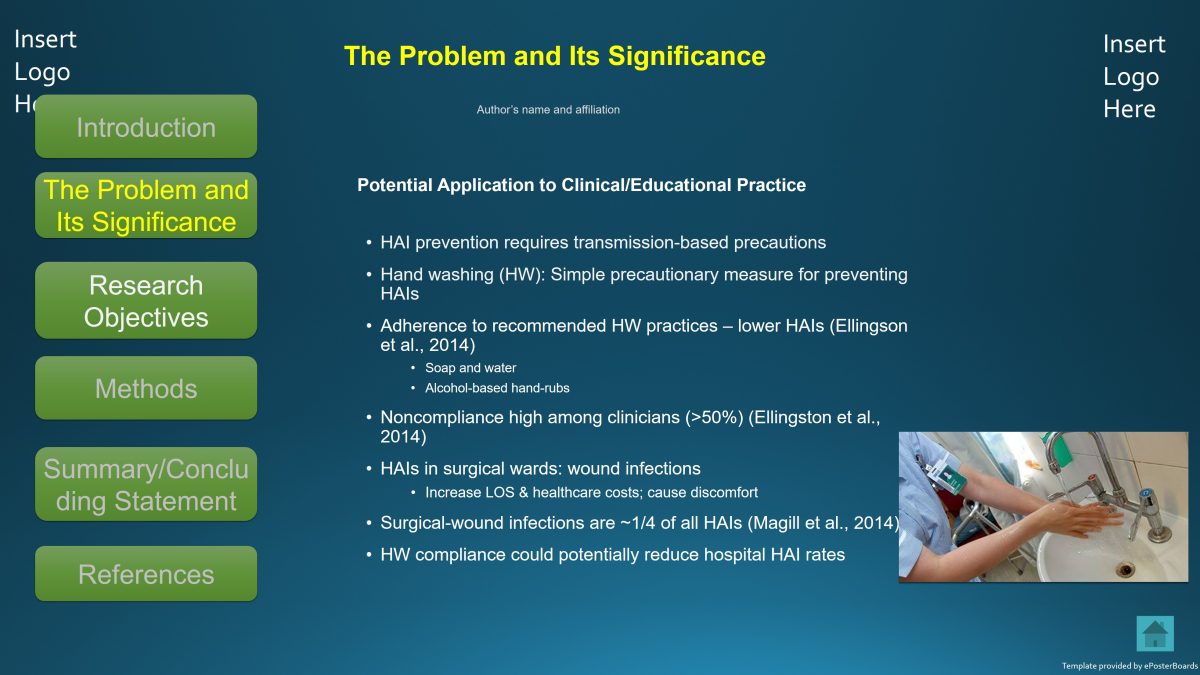
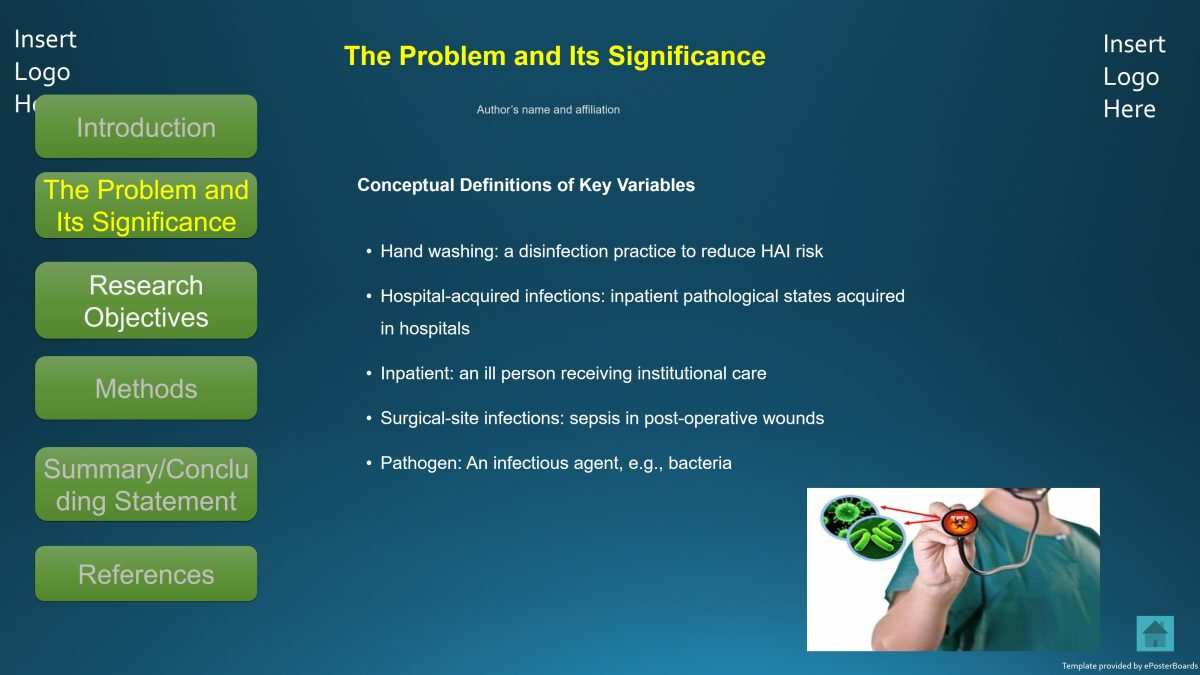
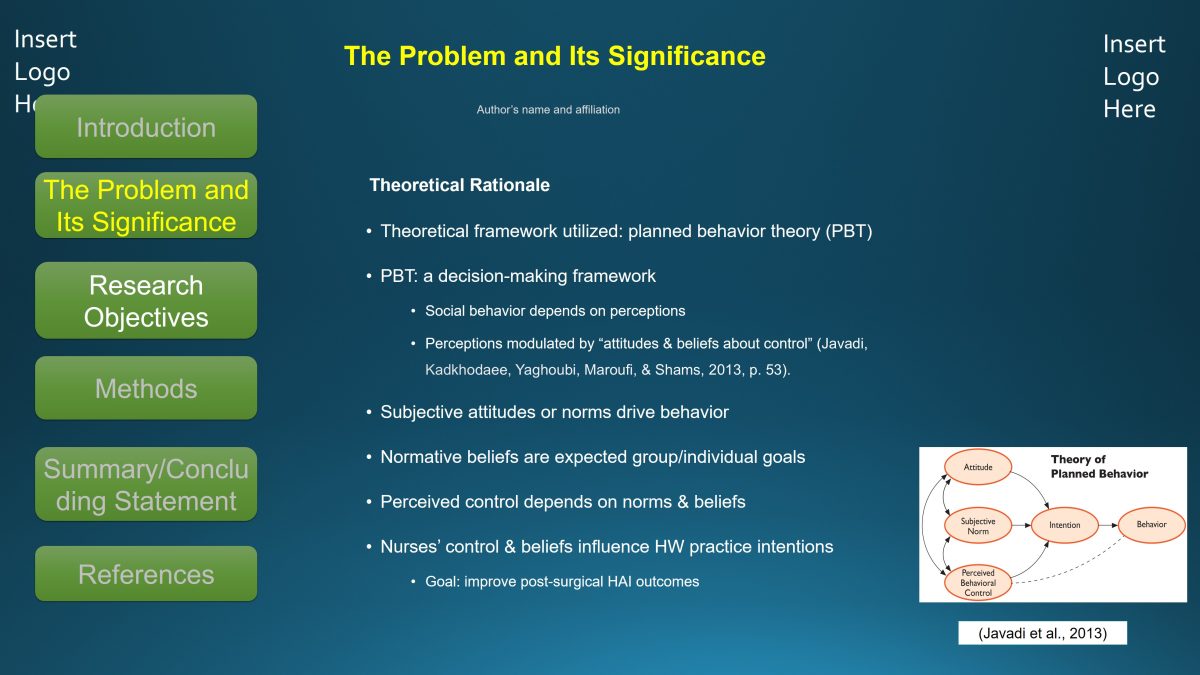
Research Objectives
- Compare pre- & post-intervention HW skills of nurses.
- Assess training impact on HAI rates.
Research Questions:
- How do pre- & post-intervention HW skills of nurses compare?
- P = staff nurses in the surgical ward;
- I= educational intervention;
- C= pre-intervention HW skills;
- O= improved HW skills;
- T= 4 weeks.
- What is the impact of training on HAI rates?
- P = staff nurses in the surgical ward;
- I= educational intervention;
- C= pre-intervention HAI rates;
- O= decline in HAI rates;
- T= 4 weeks.
Research Hypothesis:
- H1: the post-intervention HW skills of nurses > pre-intervention scores.
- H2: HAI rates will decline after the training/intervention.
Rationale:
- Inappropriate hand hygiene practices increase the HAI risk.
- Therefore, multimodal HW programs can improve HAI indicators.
- Staff training, patient education, & compliance monitoring (Ellingson et al., 2014).
- Previous studies used observations – time-consuming & limited external validity.
- The proposed quantitative study – higher generalizability to:
- Hospitals’ HW practices;
- Nursing curriculum – emphasis on HW as EBP.
- PBT theory development: education influences nurses’ safety intentions.
- Awareness of HW as EBP in HAI rate reduction.
The proposed study seeks to compare HW skills and HAI rates before and after an educational intervention for staff nurses working in a surgical unit. Its objectives are two. The first one is to compare pre-intervention and post-intervention hand washing skills of surgical staff nurses. The second one is to assess the impact of hand hygiene training of RNs on surgical-site infection rates.
The proposed study will seek to answer two research questions developed from the objectives. They include; among surgical nurses (population), how do pre- (comparison) and post-intervention (intervention) hand washing skills (outcome) compare after four weeks (time)? And, in nursing staff (P), how does training on hand hygiene (I) compared to no education (C) impact hospital-acquired infection rates (O) after a 4-week period?
The study will measure pre- and post-intervention HW skills and HAI rates before and after the training. Two clinical hypotheses are formulated based on these variables. The first one (H1) is that the post-intervention hand washing skills of nurses will be higher than the pre-intervention scores. The second hypothesis (H2) is that HAI rates will decline significantly at the hospital’s surgical ward after the 4-week training or educational intervention.
Inappropriate hand hygiene practices are associated with elevated HAI risk. Multimodal HW programs, such as staff training, patient education, and compliance monitoring, are linked to lower HAI rates (Ellingson et al., 2014). Previous studies mainly used the observation method, which is time-consuming and prone to researcher bias that limits its external validity. The rationale for using a quantitative design in the proposed study is to increase the generalizability of its results to many hospitals and nursing schools. The research will also contribute to the development of the planned behavior theory (PBT), as it will show if educational intervention influences nurses’ safety intentions. Additionally, the study will lead to greater awareness of hand washing as a hospital intervention for reducing HAI rates.
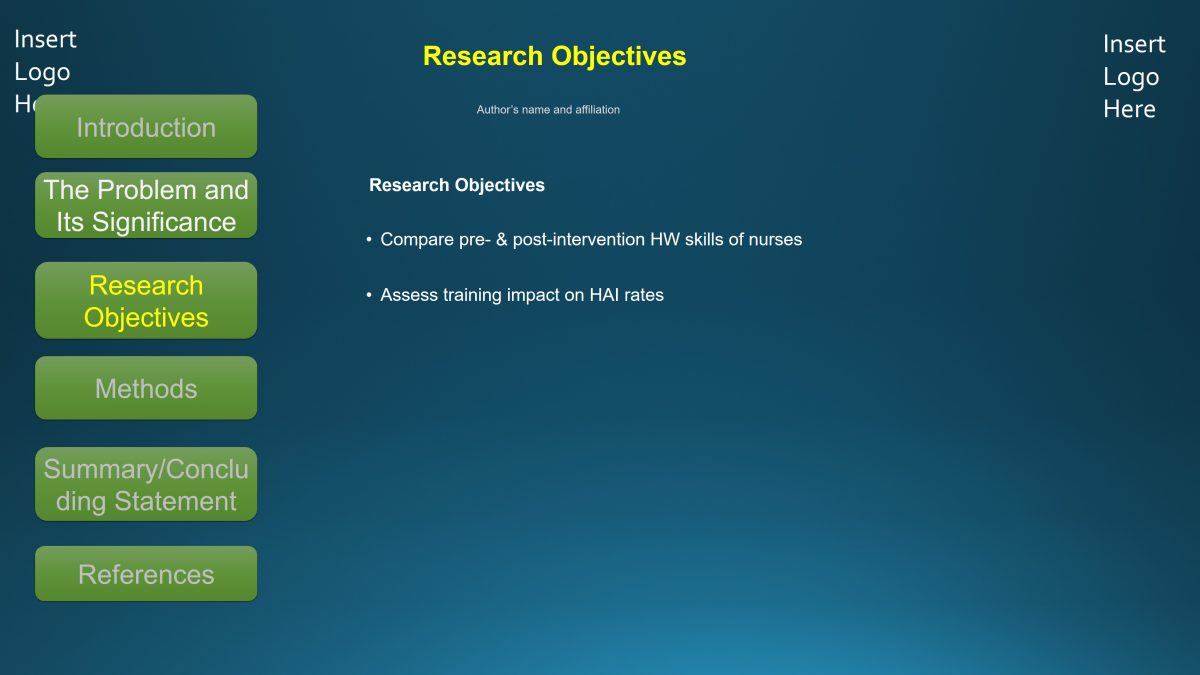
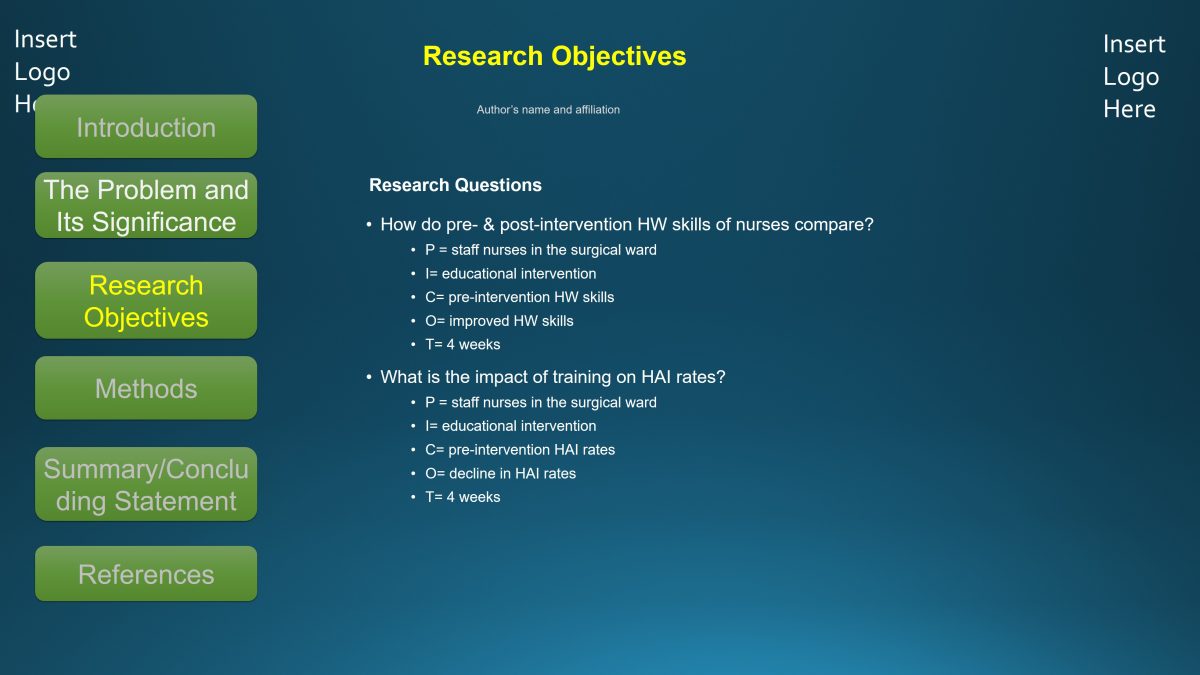
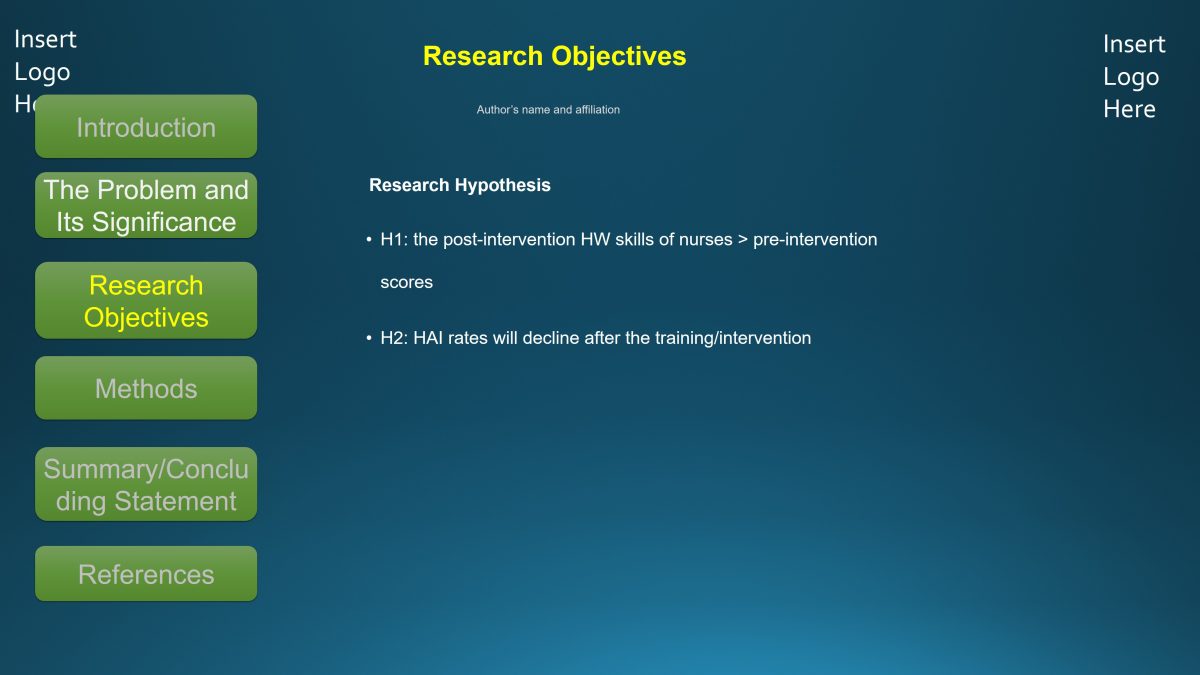
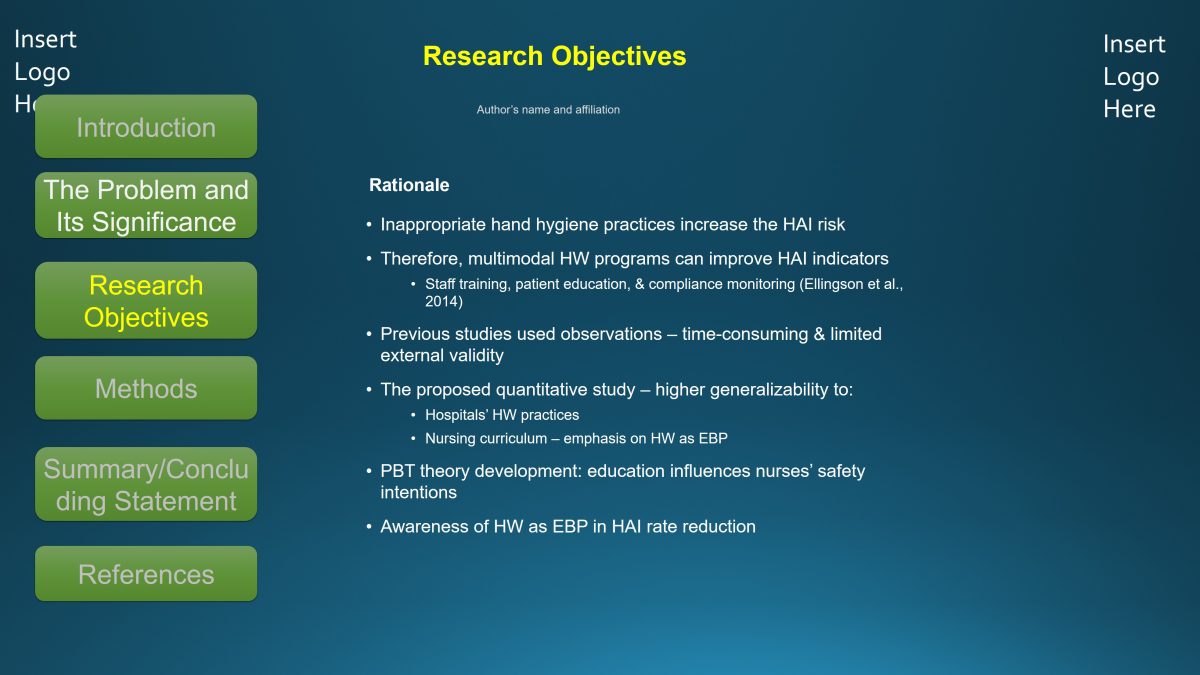
Methods
Research Design
- A quasi-experimental design.
- Comparison: pre- and post-intervention measures:
- HW skills of nurses;
- HAI rates at the surgical ward.
- Intervention: A four-week educational program designed for nurses.
- Data collection points: before & after the intervention.
- To test intervention efficacy & outcomes.
The study will use a quasi-experimental design to compare pre- and post-intervention scores on two measures: hand-washing skills of nurses and hospital-acquired infection rate at the surgical ward. The intervention will be a four-week educational program on hand hygiene designed for staff nurses. The aims are to test the efficacy of training and determine its impact on HAI rates.
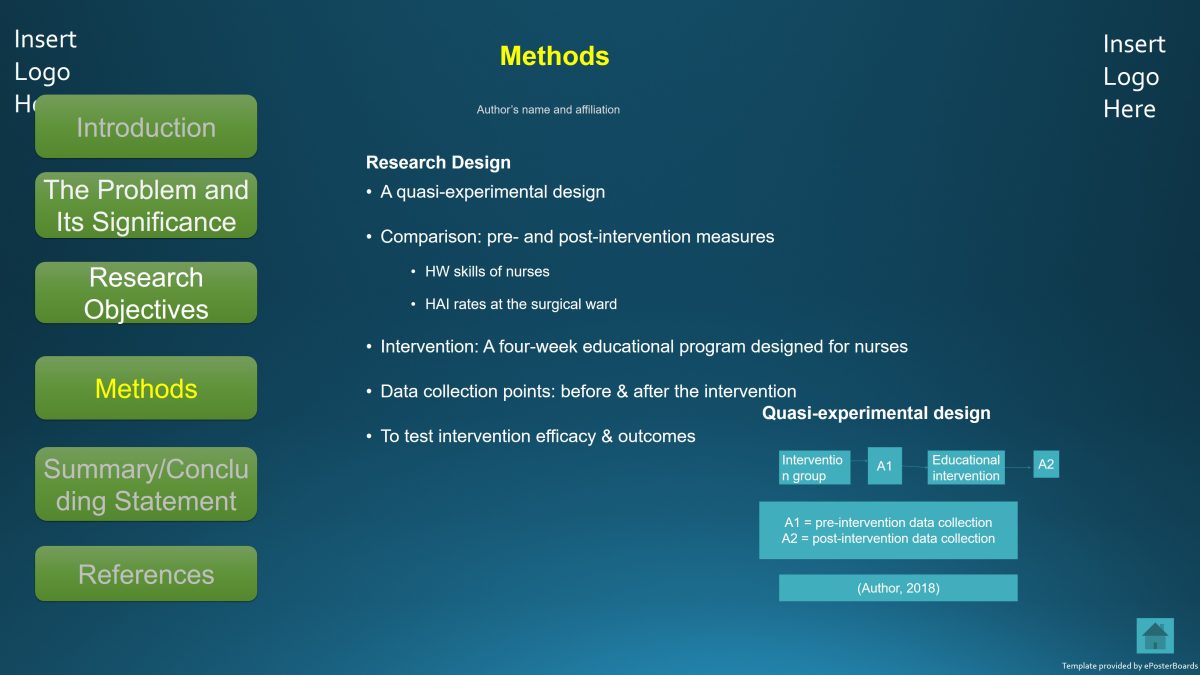
Sampling Plan
- Specific design: simple random sampling.
- A sample (N=25) drawn from surgical staff nurses.
- Representative sample – consideration for:
- Age, gender, educational level, & years of experience.
- Target population: staff nurses in a surgical ward:
- US hospital’s database.
- The nursing workforce: sampling frame.
- Inclusion Criteria:
- RNs with a BSN or its equivalent;
- Staff nurses providing direct patient care for >1 year;
- Accessible population – RNs available during data collection;
- RNs consenting to participate in HW training.
- Exclusion Criteria:
- RNS who have received HW training before;
- RNs not involved in post-operative care.
- Sample size:
- 25 RNs at a surgical ward;
- Average number of nurses in a US hospital = 250 (assumed);
- 10% of 250 = 25 subjects (adequate statistical power).
The study will employ simple random sampling design, whereby eligible staff nurses will be drawn randomly from the target population. It will involve consideration of demographic characteristics, including age, gender, educational level, and years of experience, to ensure a representative sample. The study population will be the number of nurses working at the selected facility’s surgical ward at the start of data collection. The hospital’s database will be used to draw a sampling frame. The subjects will take part in a structured educational intervention on hand hygiene delivered through an online platform.
A researcher must define the basis for including or excluding a potential subject from a study. The inclusion criteria for this study are registered nurses (RNs) possessing at least a Bachelor of Science in Nursing (BSN) or equivalent qualifications, providing direct care to postsurgical patients for a minimum of one year, accessible to the researcher during the planned data collection period, and consenting to take part in a training program on hand washing. The exclusion criteria are RNs who have undergone training on HW practices before and those not involved in caring for postoperative patients. The sample size anticipated for this research will be about 25 staff nurses based on the assumption that 10% of the target population in the hospital will give adequate statistical power to establish an effect. Therefore, assuming the facility has 250 RNs in its surgical wards, 10% of this number will give 25 subjects.
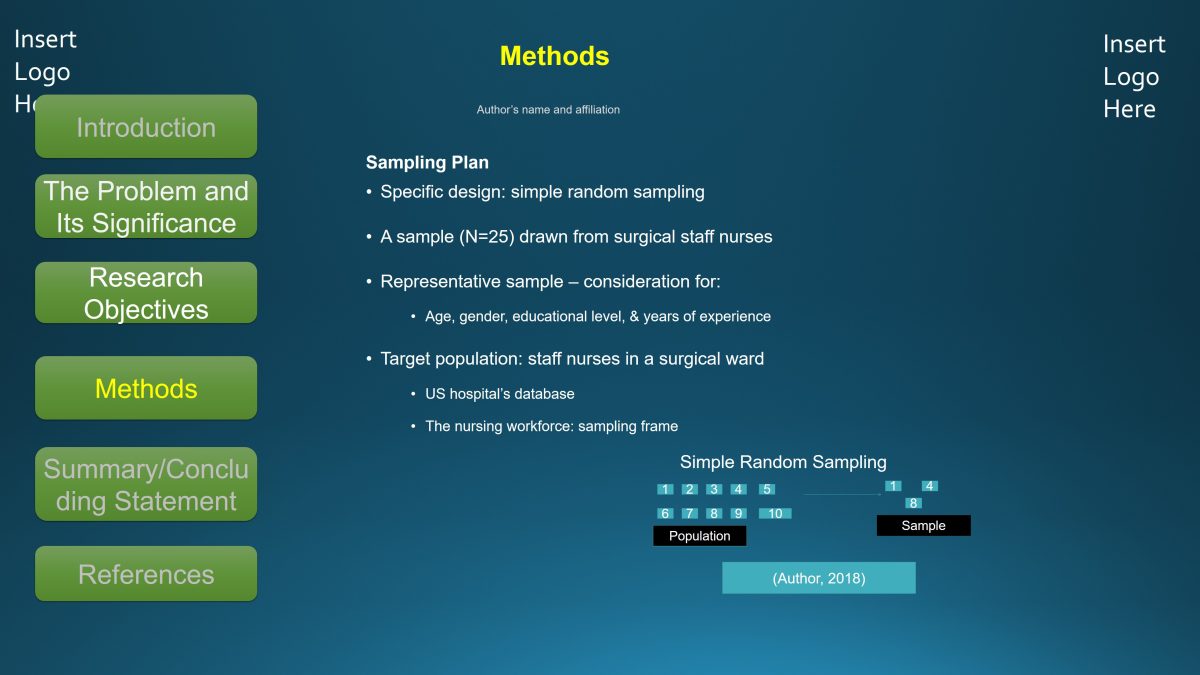
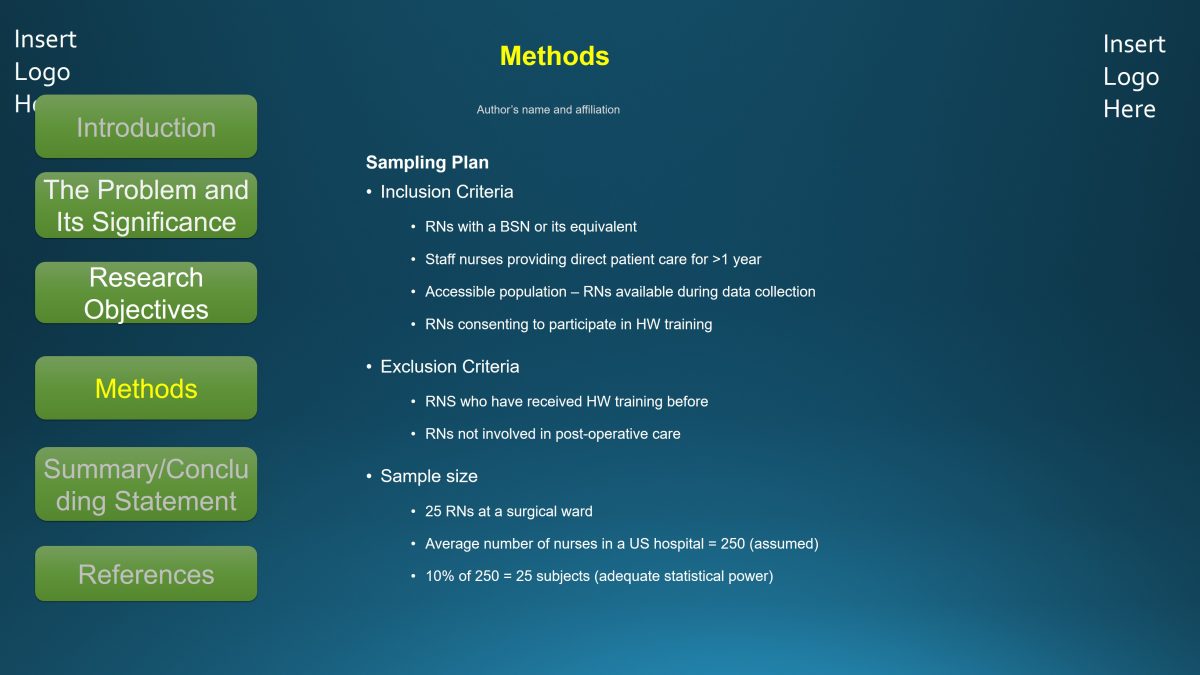
Data Collection Methods
- Facilities:
- Online informational booklets & resources (websites) – educational intervention.
- Video clips on HW practices.
- Running water, antiseptic soap, & alcohol hand-rubs – surgical ward.
- Equipment:
- Semi-structured questionnaire for data collection – demographic info & HW scores.
- HAI chart – to collect HAI episodes.
- Procedures:
- Passive recruitment approach – through the nurse manager;
- Signing of the informed consent form by the subjects;
- No control group; only intervention group;
- Pre-intervention hand washing skills measured (questionnaire);
- Baseline HAI rate at the ward recorded;
- A 4-week training on hand washing – offered online;
- Post-intervention HW skills assessed (questionnaire);
- Post-intervention HAI rate determined based on chart data.
- Ethical considerations:
- An assurance of no harm to subjects.
- Informed consent prior to participation.
- Privacy and confidentiality considerations.
- No exaggerations, coercion, or deception.
- Honest & transparent communication.
The facilities that will be used include online informational booklets and educational resources on hand washing programs that have been implemented in surgical environments. HW practice guidelines, protocols, and video clips available in websites will also be used in the training. Other facilities that will be required include running water, antiseptic soap, and alcohol-based hand-rubs stationed at the surgical wards. Data collection equipment for this study will include a semi-structured questionnaire to capture the subjects’ demographic information and HW scores before and after the intervention. Pre- and post-intervention HAI rates will be obtained using an HAI incidents chart.
The study will use a passive recruitment method. The nurse manager will help recruit eligible RNs from the surgical ward to participate in the research. The subjects will first sign an informed consent form before being allowed to take part in the study. Pre-intervention hand washing skills and baseline HAI rate will be measured using a questionnaire and a chart, respectively. Subjects will receive a four-week online training. Post-intervention HW skills and HAI rate will be obtained to determine intervention efficacy and outcomes.
The key ethical considerations in this study include ensuring that subjects are not exposed to harm throughout the research process and obtaining informed consent before allowing them to participate. Additionally, their privacy and confidentiality of the information they will give will be ensured. The researcher will ensure full disclosure of correct information about the research and honest and transparent communication to the subjects during the study. Responses to their questions or concerns will be fast and adequate.
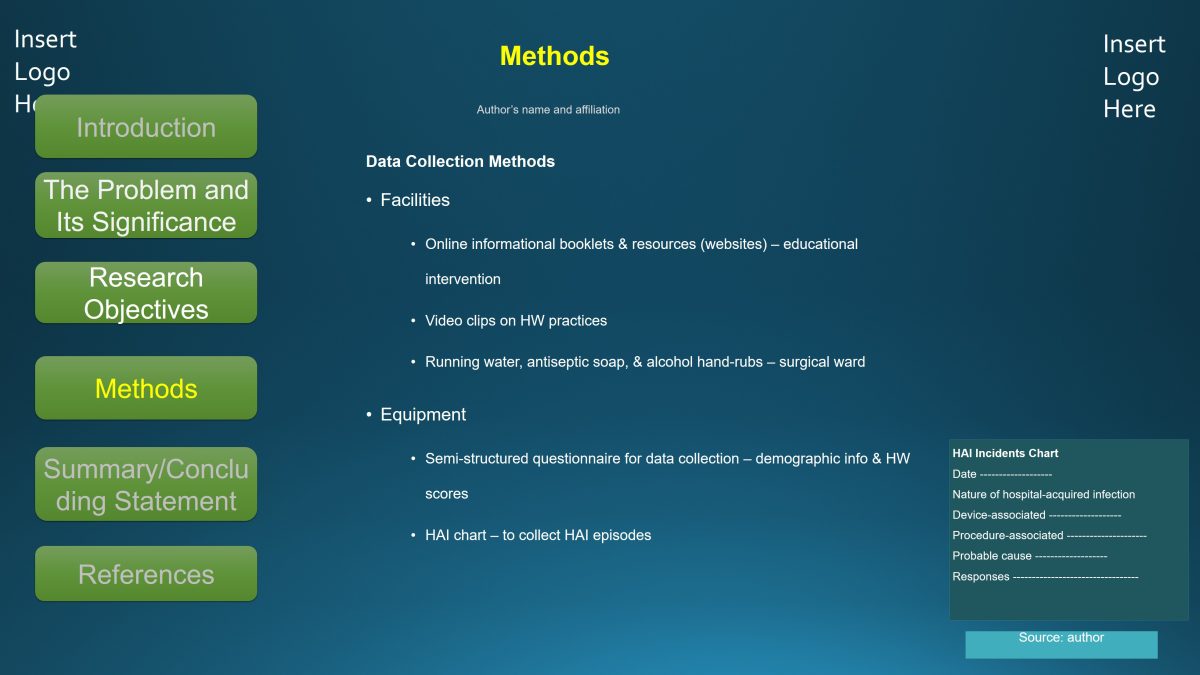
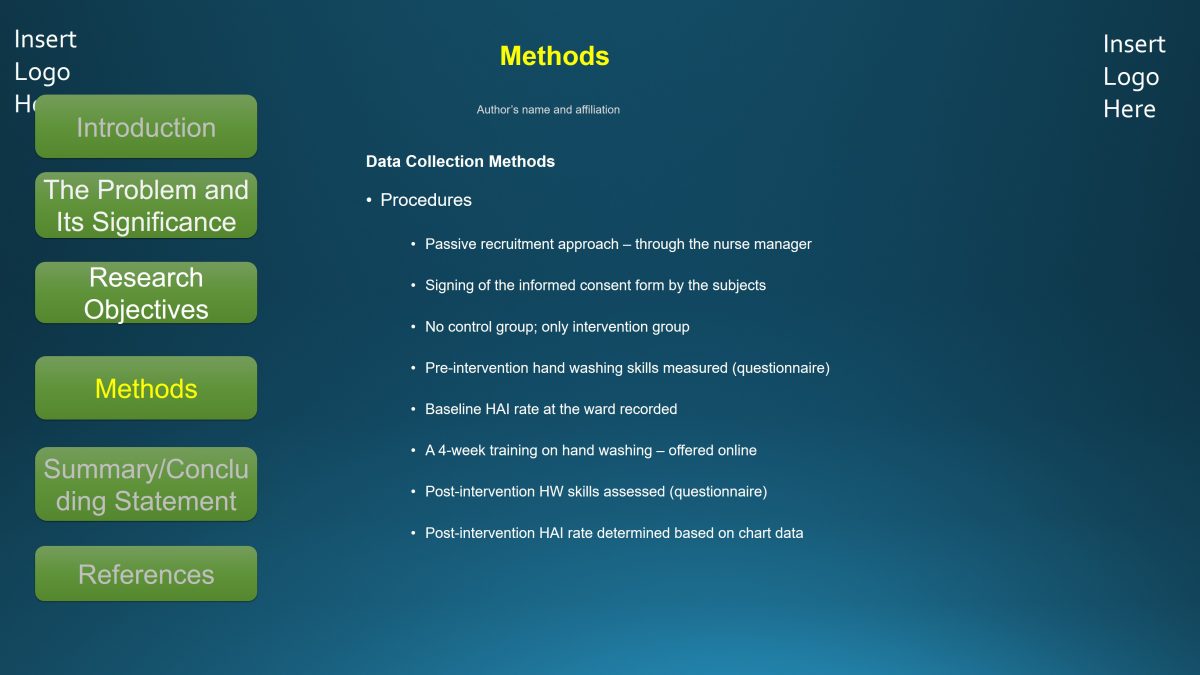
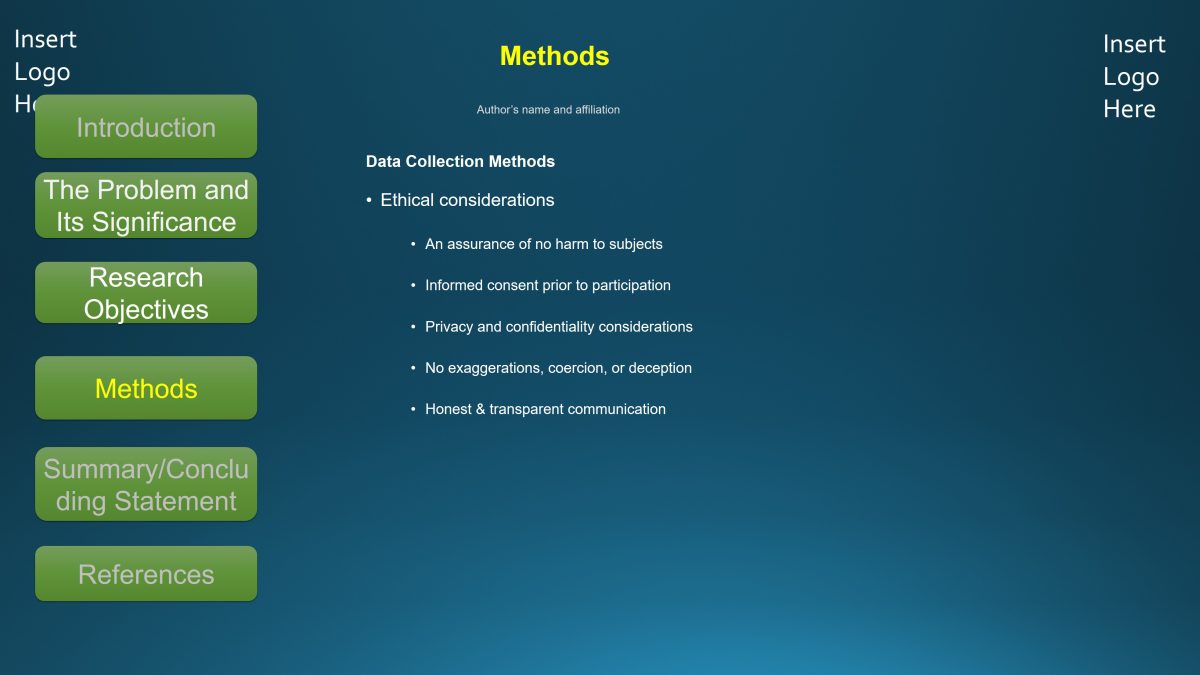
Operational Definitions of Key Variables
- Hand washing training (IV) – educational intervention for nurses.
- Improve HW knowledge for better wound care.
- Hand hygiene knowledge (DV) – subjects’ HW skills.
- Surgical site infections (DV) – HAIs occurring <30 days post-operation.
- Staff nurses – RNs providing care in surgical wards.
The independent variable (IV) is hand-washing training. It is operationalized in this study as structured instruction or educational intervention for improving staff nurses’ knowledge of hand washing practices for better post-operative outcomes. The two dependent variables (DVs) are hand hygiene knowledge and surgical site infections. The operational definition of the first variable is the skills gained from an educational program on HW practices. Surgical-site infections refer to hospital-acquired infections that occur within a 30-day postoperative period. In this study, staff nurses refer to RNs providing care in the surgical ward in which the study will take place. They constitute an important part of a hospital’s HAI control team (Rock, Harris, Reich, Johnson, & Thom, 2013).
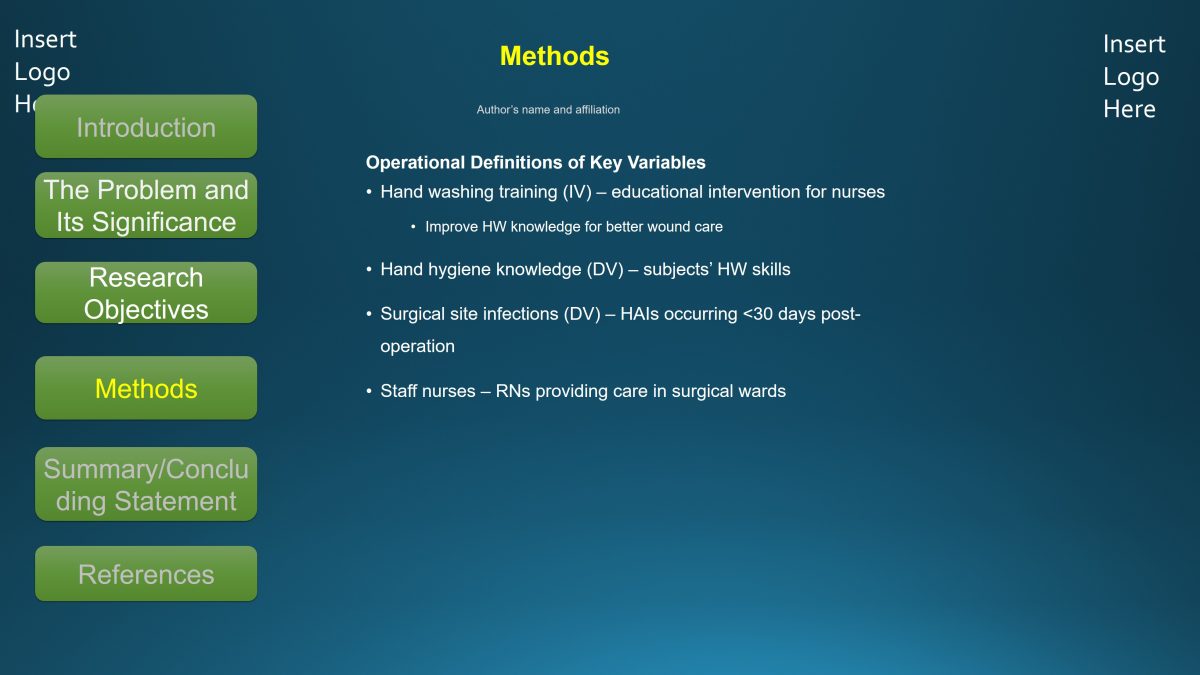
Instruments
- Description:
- HW questionnaire (HWQ) & HAI chart (HAIC);
- HWQ: measurement of HW knowledge;
- HAIC: assessment of HAI rates;
- HWQ– demographic & HW knowledge sections.
- Number of Items:
- HWQ: five items on hand washing practices;
- HAIC: three items on HAI incidents.
- Validity:
- Content validity: expert reviews of items for appropriateness;
- Revision of low-score items;
- Face validity: grammar, clarity, & relevance of items;
- Pilot reviews by staff nurses.
- Reliability:
- Test-retest procedure (5 RNs) – 14 days apart;
- Retest scores = test scores: instrument reliable.
- Scoring:
- % scores in HWQ items;
- % HAI incidents – both device-related & procedure-related.
The study will use two instruments to collect quantitative data: an HW questionnaire (HWQ) and an HAI episode chart (HAIC). The HWQ will be used to measure hand-washing knowledge of the subjects before and after an educational intervention, while the HAIC will assess the HAI rates at the surgical wards. The HWQ instrument will have two parts: demographic and HW knowledge sections. The number of items on the HWQ and HAIC will be five and three, respectively.
Content validity of the HWQ will be enhanced through expert reviews to determine the appropriateness of the items to measure the intended variables. Reviewers will rate the items as either appropriate or inappropriate and give suggestions on how to improve them. The measures with low scores will be revised to reflect their comments. Face validity will be achieved using pilot reviews involving staff nurses who will assess the grammar, clarity, and relevance of the items. Instrument reliability will be ascertained through the test-retest procedure conducted 14 days apart on a sample of five RNs. The scoring of HWQ items and HAI incidents will involve percentages.
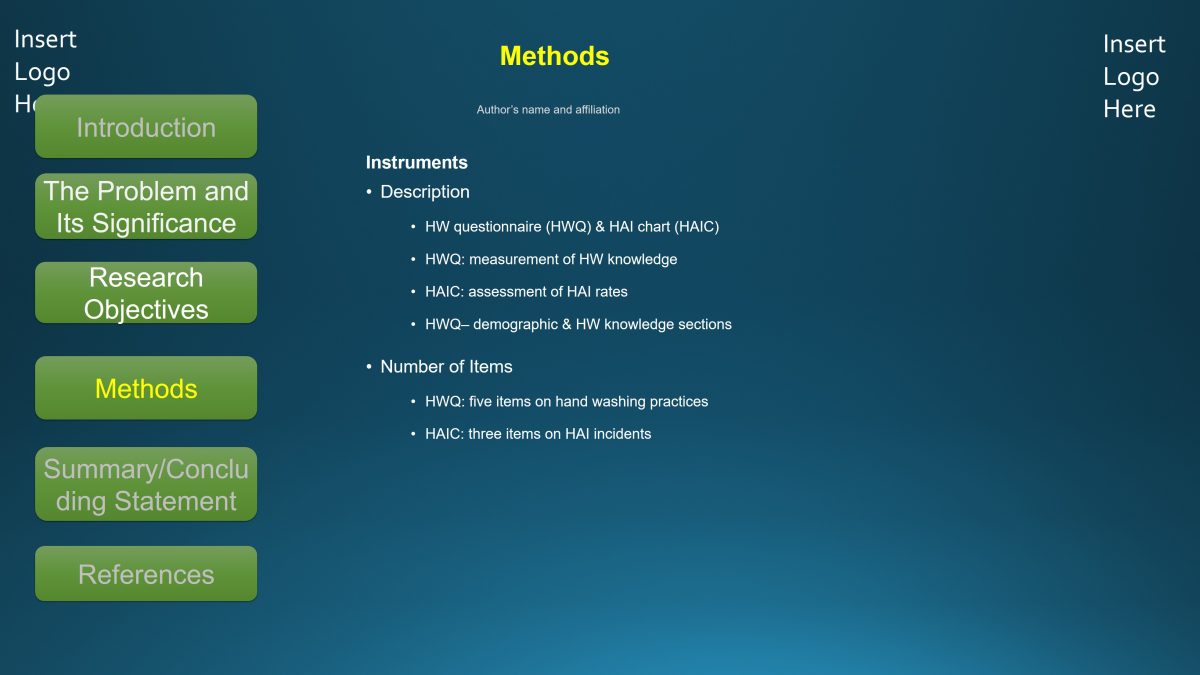
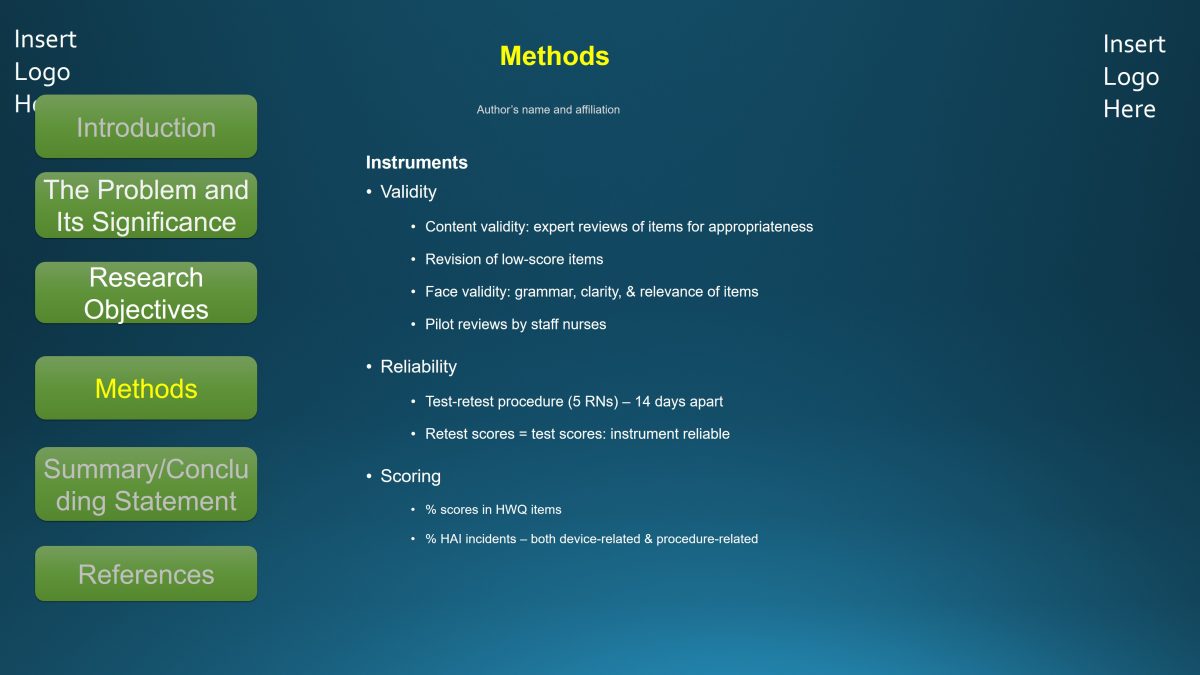
Data Analysis
- Statistics
- Descriptive statistics:
- Frequency & dispersion of demographic characteristics;
- Also, mean & variance of the subjects’ HW knowledge.
- Inferential statistics:
- T-test: comparison of pre- & post-intervention HW data & HAI rate;
- Chi-square test: correlations between post-intervention HW knowledge & demographic characteristics.
- Software:
- Statistical Package for Social Scientists (SPSS).
The analysis plan will involve sorting and entering the data from the HW questionnaire and HAI chart into the Statistical Package for Social Scientists (SPSS) software for descriptive and inferential analysis. Thus, the procedure will proceed in two steps. In descriptive statistics, the frequency and dispersion of the demographic characteristics of the subjects will be determined. This method will also give the mean and variance of HW knowledge among staff nurses in the surgical ward. In inferential statistics, a t-test will be employed to compare the pre- and post-intervention data on HW knowledge of the subjects. Additionally, chi-square tests will be utilized to establish a correlation between post-intervention HW knowledge values and age, educational level, or years of experience.
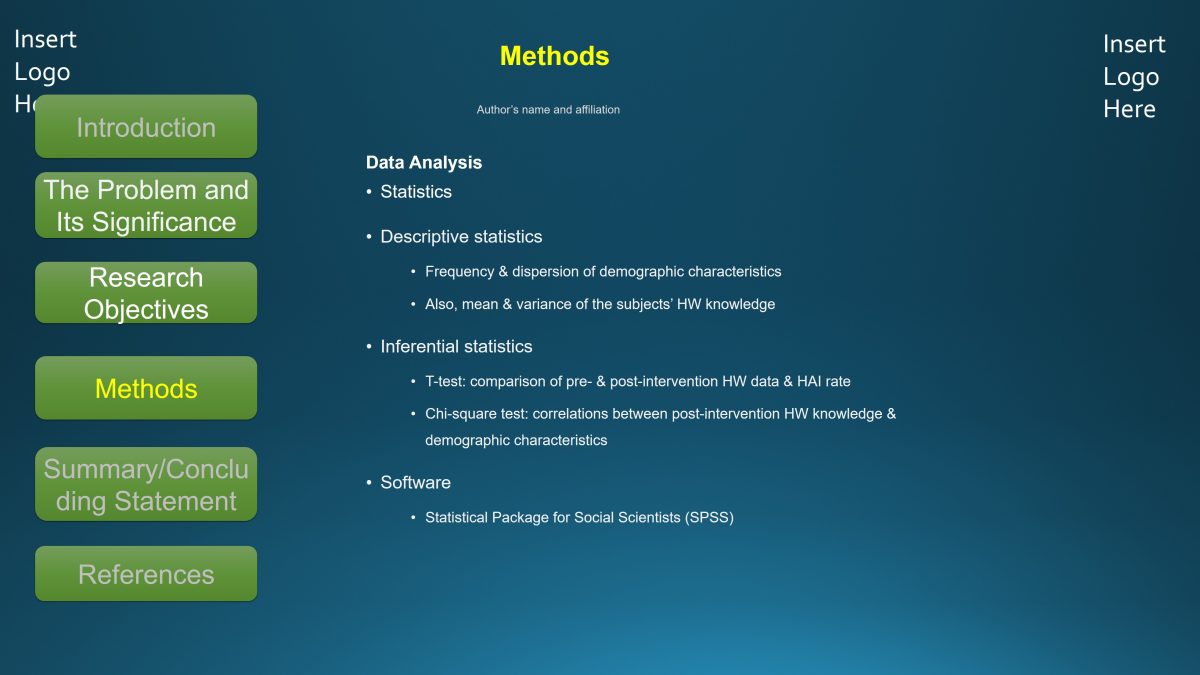
Methods of Safeguarding Human Subjects
- Maintaining confidentiality:
- Protection of the subjects’ right to privacy;
- Unique identifiers/codes during recruitment – no actual name or address;
- Web-based delivery of training & questionnaire – to maintain anonymity.
- Securing informed consent:
- Participant information sheet: study purpose, design, & benefits;
- Consent form: each subject’s obligations, e.g., voluntary withdrawal.
- Minimizing risks:
- Convenient access to online training material & resources;
- No exposure to more harm than normal;
- Nondisclosure of subjects’ identities or addresses;
- No monetary incentive for participation.
Safeguarding of human subjects will involve maintaining subject confidentiality using unique identifiers instead of names or addresses. The training and questionnaire administration will also be web-based to preserve participant anonymity. Informed consent will be sought before the study. An information sheet will indicate the study’s purpose, design, and potential benefits. Risks to the subjects will be minimized through convenient access to online training resources and nondisclosure of participant identity or address.
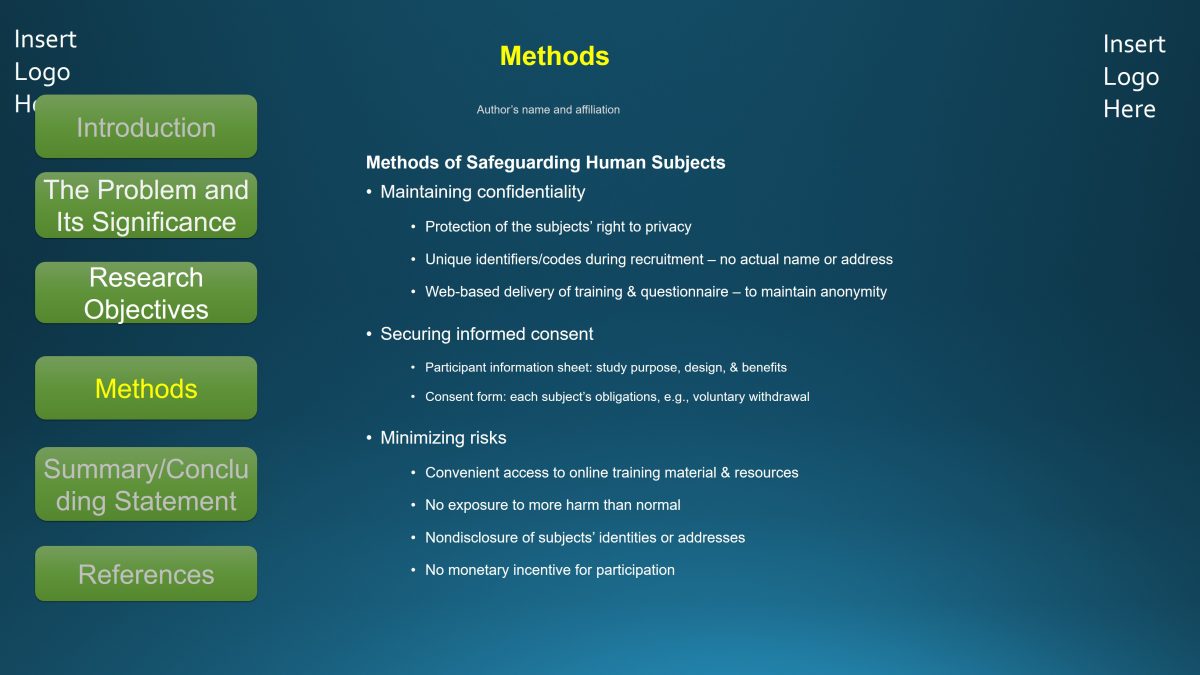
Summary/Concluding Statement
- HAIs account for high morbidity, mortality, & costs;
- HW – A basic precautionary measure for preventing HAIs;
- Objectives:
- Compare nurses’ pre- & post-intervention HW knowledge;
- Assess training impact on surgical-infection rates.
- Quasi-experimental design & sample of 25 surgical nurses;
- Intervention: A 4-week online education program;
- Quantitative measures investigated:
- HW knowledge & surgical-site infection rate.
- Study implications:
- Emphasis on HW practices by hospitals & academia;
- Refresher courses to promote compliance.
Hand washing (HW) is a fundamental to safe clinical practice. Adherence to HW guidelines can reduce hospital-acquired infections (HAI) that are associated with high morbidity, mortality, and healthcare costs (Magill et al., 2014). The proposed study will use a quasi-experimental design; 25 RNs will receive a 4-week online educational intervention and their pre- and post-intervention knowledge and HAI rates compared. The study has implications for hospital safety practice or policy and nurse training programs.
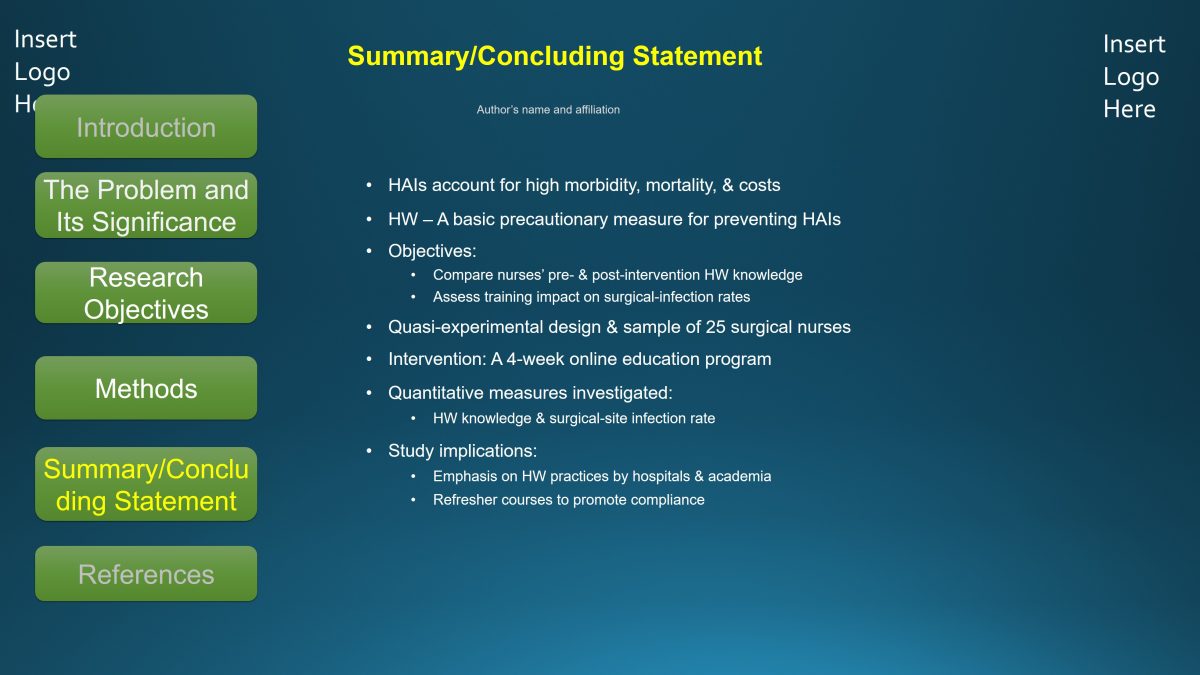
References
Al-Tawfiq, J. A., Abed, M. S., Al-Yami, N., & Birrer, R. B. (2013). Promoting and sustaining a hospital-wide, multifaceted hand hygiene program resulted in significant reduction in health care-associated infections. American Journal of Infection Control, 41(6), 482-486. Web.
Ellingson, K., Haas, J. P., Aiello, A. E., Kusek, L., Maragakis, L. L., Olmsted, R. N., … Yokoe, D. S. (2014). Strategies to prevent healthcare-associated infections through hand hygiene. Infection Control and Hospital Epidemiology, 35(8), 937-960. Web.
Javadi, M., Kadkhodaee, M., Yaghoubi, M., Maroufi, M., & Shams, A. (2013). Applying theory of planned behavior in predicting of patient safety behaviors of nurses. Materia Socio Medica, 25(1), 52-55. Web.
Magill, S. S., Edwards, J. R., Bamberg, W., Beldavs, Z. G., Dumyati, G., Kainer, M. A., … Fridkin, S. K. (2014). Multistate point-prevalence survey of health care-associated infections. The New England Journal of Medicine, 370, 1198-1208. Web.
Park, H. Y., Kim, S. K., Lim, Y. J., Kwak, S. H., Hong, M. J., Mun, H. M., … Choi, S. H. (2014). Assessment of the appropriateness of hand surface coverage for health care workers according to World Health Organization hand hygiene guidelines. American Journal of Infection Control, 42(5), 559–561. Web.
Rock, C., Harris, A. D., Reich, N. G., Johnson, J. K., & Thom, K. A. (2013). Is hand hygiene before putting on nonsterile gloves in the intensive care unit a waste of health care worker time? A randomized controlled trial. American Journal of Infection Control, 41(11), 994–996. Web.